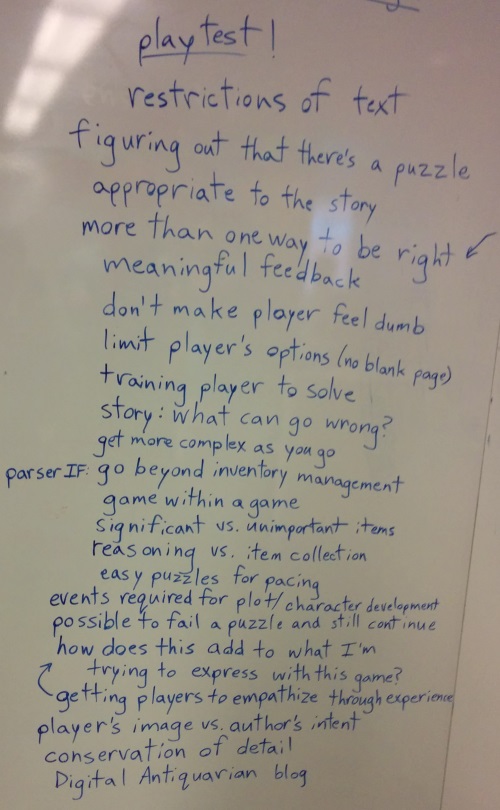Back in August, I attended Boston GameLoop, an annual game development unconference. I’ve been going for years, and I’m always impressed by the sheer wealth of knowledge available.
I take notes. Lots of notes. And I’m writing up my notes from this year (in fleshed-out form) for everyone who wasn’t there.
GameLoop participants: Apart from the discussion leaders, I have not attached anyone’s names to these writeups, and I’ve mostly scrubbed personal anecdotes out to maintain the privacy of attendees. Please contact me (carolyn at sibylmoon.com) if:
- I included something you said that should not be included, or
- I quoted you without attributing (when you would prefer attribution), or
- You think I got something from the discussion wrong
…and I’ll make a correction. Thanks!
Puzzles and Narrative Design
Discussion leader: Naomi Hinchen
How do you know if your puzzles are accessible and logical? Playtest!
Does a puzzle make sense to the story? It shouldn’t be there if it doesn’t fit.
Look for opportunities for puzzles to develop naturally from the story. Ask yourself, “What can go wrong in this situation?” Then make it go wrong, and turn it into a puzzle.
Alternately, you can start with a core puzzle mechanic and then wrap a story and game around that mechanic. Go deep, not wide. (Example: Portal.)
Puzzles should start less complex and become more complex over time. Ease the player into it. Andrew Plotkin’s Hadean Lands is a good example of this.
Make sure that players know a puzzle exists. It’s frustrating what to do next – the way forward can’t be totally opaque.
Puzzles can have multiple solutions. Emily Short’s Counterfeit Monkey is a wordplay game with multiple solutions possible to each puzzle.
Nothing is so frustrating as a situation where a puzzle solution should work but isn’t recognized. Find possible multiple solutions with playtesting. Implement them.
Nothing is more frustrating than the blank page. Limit player options so they have some idea about what they should be doing t any given time.
Use meaningful feedback to the players so that it’s clear whether they’re on the right track.
Think outside inventory management (especially in parser IF)! If gathering objects does not involve conscious thought, then it’s not a puzzle.
Skyrim demonstrates an anti-hoarding mechanic – there are too many items to effectively collect them all.
1st Gabriel Knight also – you could interact with anything, but often nothing happened.
Some puzzles are simulated games within games (chess, tic tac toe, Go, Sokoban, etc.)
Puzzles are ways to pace a game and ways to place emphasis on particular aspects of a game.
The line between “this is a puzzle” and “this is a simulation that requires interaction” can be very fine.
It can be possible to “fail” a puzzle and still continue forward.
For any puzzle: how does this add to what I’m trying to express with this game? You can get players to empathize through experience.
How do you communicate character and identity through puzzles?
This War of Mine and Papers, Please are two games where narrative and mechanics work in strong parallel. Also The Walking Dead.
Keep in mind – the player may not see what you wanted them to see. Their opinion always wins. Playtest to figure out what’s happening.
By conserving detail elsewhere, you can draw the player’s attention to important things. (This works both textually and visually – the more eyecatching something is, or the more detail something is described with, the more emphasis it will have in the minds of players.)
Good vs. bad design: see Digital Antiquarian’s “The 14 Deadly Sins of Graphic-Adventure Design”, which hearkens back to Ron Gilbert’s “Why Adventure Games Suck” (from 1989)
Automatic note-taking by the PC can be very helpful for complicated puzzles, or anything involving extended lore and worldbuilding.
Sherlock Holmes: The Awakened – the player was responsible for explaining the solution to Dr. Watson.
Clear goal-setting is critical.
Things that make for bad puzzles:
- Not giving the player enough training/context to know what to do
- Broken Age 2 example: wiring robot friend together – too hard and confusing, breaks the game’s internal logic
- Having insufficient information inside the game to solve the game
- Depending on cultural knowledge
- Zork 2 baseball puzzle
Interesting (potentially problematic) metapuzzles:
- The Legend of Zelda: Phantom Hourglass – the moment when you have to close the DS
- CYOA Inside UFO 54-40 – an ending that was impossible to reach without cheating
The metapuzzle idea was subverted interestingly in Simon Christiansen’s “Trapped in Time”.
This site is supported through Patreon. Please consider becoming a patron!




Thanks for posting! If you want to link to my Twitter, it’s @RobotKitten121. (Also, one of the pictures I tweeted shows the second column of whiteboard notes, so you might want to add it.)
Twitter link added!
I got photos of both sides, but I didn’t feel that the second photo added much information, so I left it out of the main article. But for anyone who’s curious, here’s Naomi’s link!
https://twitter.com/RobotKitten121/status/632655984792616960
“Skyrim demonstrates an anti-hoarding mechanic – there are too many items to effectively collect them all.”
Doesn’t that just mean the player will agonize over which ones they have to leave behind every time they find some more items, while feeling cheated that they couldn’t get them all?
Depends on the player, but Skyrim hoarding is definitely a thing that happens.
https://www.youtube.com/watch?v=s9sE8Xyids4